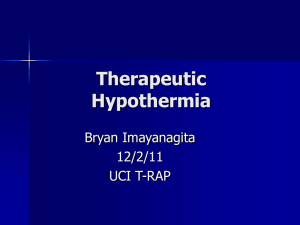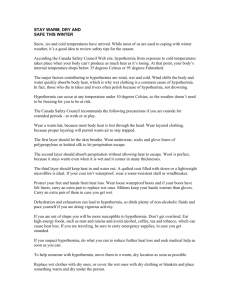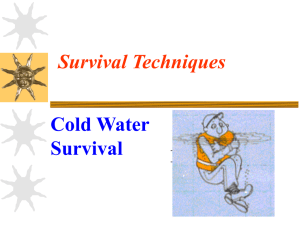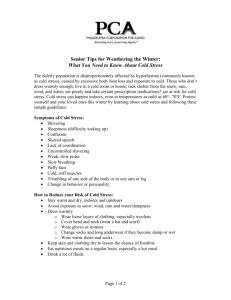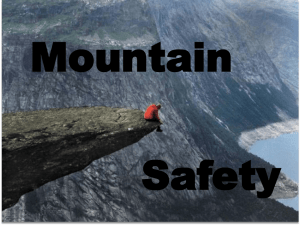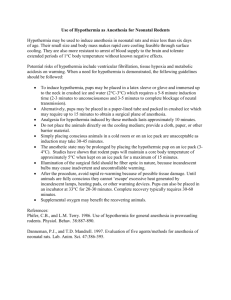Use The 100 Degree Rule
advertisement
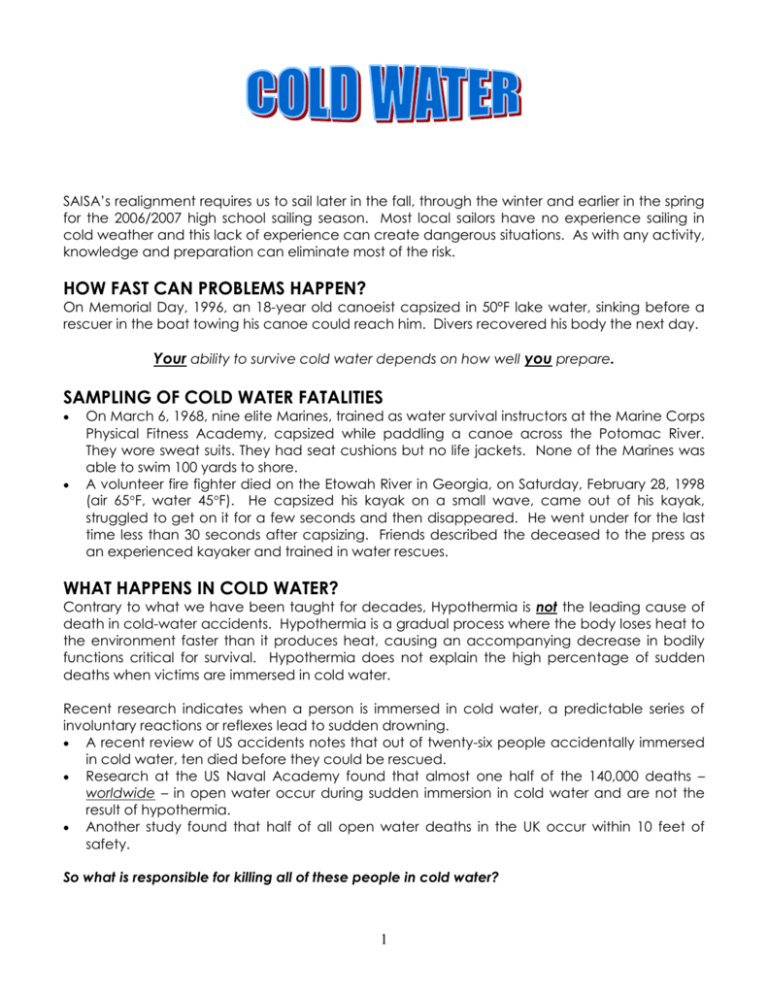
SAISA’s realignment requires us to sail later in the fall, through the winter and earlier in the spring for the 2006/2007 high school sailing season. Most local sailors have no experience sailing in cold weather and this lack of experience can create dangerous situations. As with any activity, knowledge and preparation can eliminate most of the risk. HOW FAST CAN PROBLEMS HAPPEN? On Memorial Day, 1996, an 18-year old canoeist capsized in 50°F lake water, sinking before a rescuer in the boat towing his canoe could reach him. Divers recovered his body the next day. Your ability to survive cold water depends on how well you prepare. SAMPLING OF COLD WATER FATALITIES On March 6, 1968, nine elite Marines, trained as water survival instructors at the Marine Corps Physical Fitness Academy, capsized while paddling a canoe across the Potomac River. They wore sweat suits. They had seat cushions but no life jackets. None of the Marines was able to swim 100 yards to shore. A volunteer fire fighter died on the Etowah River in Georgia, on Saturday, February 28, 1998 (air 65°F, water 45°F). He capsized his kayak on a small wave, came out of his kayak, struggled to get on it for a few seconds and then disappeared. He went under for the last time less than 30 seconds after capsizing. Friends described the deceased to the press as an experienced kayaker and trained in water rescues. WHAT HAPPENS IN COLD WATER? Contrary to what we have been taught for decades, Hypothermia is not the leading cause of death in cold-water accidents. Hypothermia is a gradual process where the body loses heat to the environment faster than it produces heat, causing an accompanying decrease in bodily functions critical for survival. Hypothermia does not explain the high percentage of sudden deaths when victims are immersed in cold water. Recent research indicates when a person is immersed in cold water, a predictable series of involuntary reactions or reflexes lead to sudden drowning. A recent review of US accidents notes that out of twenty-six people accidentally immersed in cold water, ten died before they could be rescued. Research at the US Naval Academy found that almost one half of the 140,000 deaths – worldwide – in open water occur during sudden immersion in cold water and are not the result of hypothermia. Another study found that half of all open water deaths in the UK occur within 10 feet of safety. So what is responsible for killing all of these people in cold water? 1 Cold Shock The momentum of an individual falling overboard usually drives the victim under the surface for several seconds. “Cold Shock” is the term used to describe a series of rapid, linked, involuntary and detrimental physiological events in the human body characterized by immediate loss of breathing control when suddenly immersed in cold water. These immediate body responses or reflexes are increasingly fatal as water temperature decreases. In cold water, submerged victims may inhale water. This is the “involuntary gasping reflex” (see photo). Loss of breathing control begins the moment cold water makes contact with skin and triggers a series of deep involuntary gasps for air. When immersed, the involuntary gasping reflex draws water into the lungs and victims can drown without coming back to the surface. In some cases, the shock of sudden exposure to coldwater causes muscles surrounding the trachea (windpipe) to close and stay closed. This loss of control prevents breathing when the victim surfaces. Typically, the victim, now unable to breath, is last seen struggling briefly at the surface before disappearing from view. Researchers have found that the involuntary gasping reflex and loss of breathing control peaks within 30 seconds of being exposed to cold water and can last up to three minutes. The shock of sudden exposure to cold water can also render the victim unconscious instantly. Typically, survivors of the involuntary gasping reflex and the loss of breathing control period experience hyperventilation, with rate of breathing increasing up to five times the normal rate. Sudden exposure to cold water also causes rapid increases in heart rate and blood pressure that may result in cardiac arrest. Twenty percent of all cold-water immersion deaths occur after the victim is retrieved from the water. Hypothermia The purpose of this write-up is not to downplay the risk of Hypothermia. If a victim survives the immediate consequences of Cold Shock, Hypothermia begins to take its toll. As mentioned before, Hypothermia develops more slowly than the immediate effects of Cold Shock. Without thermal protection, long-term survival in cold water is not possible. Without a life jacket, drowning is unavoidable. The victim, though conscious, is soon helpless. Heat Loss Facts 1. The body loses heat 25 – 30 times faster in cold water than in cold air. 2. Fifty percent (50%) of heat loss occurs through the head. 3. Any movement or physical activity such as swimming or other struggling in the water increases heat loss. 4. Cold water reduces survival time to minutes. 2 Cold Water Temperatures Decreases Time Before Exhaustion & Decreases Survival Time Water Temp (°F) Exhaustion or Unconsciousness Survival 32.5 Under 15 minutes 45 minutes 32.5-40 15-30 minutes 30-90 minutes 40-50 30-60 minutes 1-3 hours 50-60 1-2 hours 1-6 hours 60-70 2-7 hours 2-40 hours 70-80 3-12 hours 3 hours to indefinite Over 80 Indefinite Indefinite Swimming ability in warm summer water has nothing to do with survival in cold water. HOW COLD IS COLD? How cold is it? Simply knowing the outside air temperature will not tell you enough about conditions to enable you make an intelligent and informed decision for cold-water boating. Wind Speed Wind speed has an effect. The combined effect of wind speed and temperature determines the rate at which your body loses heat. This combined effect is the "wind chill factor." “Wind chill factor” is the temperature required under no-wind conditions that will equal the cooling effect of the air (the actual air temperature) and the wind on an average size, nude person in the shade. The following wind chill table serves as one tool in determining how much protective clothing to wear. The following table shows how the wind chill factor increases as the wind speed increases. Equivalent temperatures shown are valid only if you are wearing dry clothing. 3 Keep the following issues in mind: Winter months often bring windier conditions than normal. The speed of your boat creates stronger apparent winds. Increased wind speed increases the rate of evaporation of moisture from exposed skin. This not only will make a person "feel" cooler, but also will actually lower the skin temperature, and consequently, internal body temperature. Water Temperature Cold water has a number of definitions. In Alaska, sources define water temperatures under 77°F as cold. In British Columbia, the definition of cold water is water temperature below 70°F. US Coast Guard statistics show that 75% of all kayaking and canoeing fatalities occur in water with a temperature below 65°F. The American Canoeing Association recommends wearing “specialized clothing” whenever water temperature is below 60°F. Regardless of the definition of cold water, studies show that when a person is immersed, the major factor in determining the length of time the person can survive is the water temperature. The following survivability chart assumes sea conditions are not a factor; the person is an average swimmer, in average physical condition, with no special clothing. The Danger Zone indicates where safety precautions and appropriate behavior (adopting H.E.L.P.) increases your chances of survival when immersed in cold water. WHAT CAN I DO? Most cold-water boating disasters are easily preventable with proper preparation. Wearing properly fitted life jackets (one with a snug fit that keeps your nose, mouth and head out of the water) saves boaters in cold-water situations. Boaters wearing life jackets do not sink as far under the water before bobbing back to the surface. Their heads may not go under at all. The devastating effects of the Cold Shock are greatly reduced. Even if they inhale some water, they still have a chance of survival or rescue because they will not immediately sink. It seems that nothing will convince boaters to wear wetsuits or dry suits when boating in cold water. Why? Because wetsuits and dry suits are not sexy and make our butts look big. Technology is our ally. New products are available in a wide range of comfortable and inexpensive clothing that provide adequate thermal protection. Avoid wearing cotton when boating in cold water. Dress in layers of synthetic fabrics such as polyester fleece. Add or remove layers to prevent overheating or being chilled from sweating. Wear a waterproof shell designed for splash or rain protection. Wear a warm hat that stays on your head. Take care of 4 your torso, head and neck first. If you decide to put fashion aside and wear a wetsuit or dry suit, remember the following: Wetsuits: Do not wear clothes under a wetsuit. The insulating value of a wetsuit is based on the ability to trap water next to skin, creating a microclimate of warm water. Wearing clothes under a wetsuit allows the water to move and creates heat loss. Dry Suits: Dry suits are one hole away from being a wetsuit. Dry suits have no insulating value. One source states that without thermal clothing underneath, dry suits provide no protection from Cold Shock. Clothes that keep you warm in the woods or on the slopes are useless in the water Test Yourself One of the best indicators of when someone is becoming hypothermic is if they begin to shiver uncontrollably while at rest. Being at rest is important because the body heat generated by the simplest exercise tends to temporarily mask the onset of hypothermia. Take frequent breaks and check to see if you or others begin to shiver. At what temperature should you wear a wetsuit or dry suit? How did you do on the test outlined above? If you are uncertain, the following chart can help you decide. Water Temp (°F) How Water Feels What Type of Suit to Wear 80 °F + Bath Water None Needed 72-80 °F Comfortable Wetsuit Trunks or Shorty or Sleeveless Shorty 65-72 ° F Cool at First Short John Arms / Full Leg Wetsuit 60-65°F Very Chilly Full Wetsuit or Drysuit 50-60°F Extremely Chilly Full Wetsuit or Drysuit or Short John Arms / Full Leg Wetsuit with Jacket Below 50°F May Cause Shock use caution Full Wetsuit or Drysuit with gloves, hood, and booties (if applicable) Use The 120° Rule. A good rule of thumb to follow is the "120° rule." This means you should wear a wetsuit or dry suit whenever the sum of the air temperature and water temperature is equal to or less than 120°F. Warm weather does not cancel out the danger of cold water, wearing lighter clothing on a warm day increases risk. Anti-immersion suits are worn by military aircrews to retain body heat if the aircrew must ditch in the water. Like sailors, aircrews do not like to wear the gear because it is bulky and hot. When environmental conditions indicate usage is required, Commanding Officers include the following recommendations in preflight briefings. 5 Anti-immersion suits or pressure suits with thermal undergarments must be worn when the coldest water temperature in the mission area is below 50°F or if the coldest wind-chill equivalent temperature on the surface of the water during the mission is less than 32°F. When the water temperature is less than 60°F but greater than 50°F, anti-exposure undergarments must be worn. The determination to wear anti-immersion suits is made by the Commanding Officer, with the determination based on the length of time required to respond with rescue assets to a ditch site, ranging from 1 hour at 50°F to 3 hours at 60°F. With water temperatures above 60°F, anti-immersion gear is not required WHAT TO DO IF YOU GO INTO COLD WATER First, do not panic. “Could have”, “Should have” and “Would have” do not count. If your boat capsizes, it will float on or just below the surface. Boats built after 1978 are designed to support you even if full of water or capsized. To reduce the effects of hypothermia get in or on the boat. Try to get as much of your body and especially your head and neck, out of the water as possible. Dr. Gordon Giesbrecht, a thermophysiologist at the University of Manitoba developed a concept called 1-10-1, short for “1 minute – 10 minutes – 1 hour”, an easily remembered strategy for managing sudden cold-water immersion. The time scale is approximate, but the essential strategy remains valid for all water temperatures below 59°F. According to Dr. Giesbrecht, “Your goal must be to live long enough to actually risk dying from hypothermia.” One Minute Once you fall into cold water, you will hyperventilate for one minute. Take the time to get control of your breath and keep your head clear of the water. Do not panic. It helps to know that your breathing will settle down. Take stock of your surroundings and plan your next steps. Ten Minutes Next, you will have approximately ten minutes of reasonable mobility and dexterity. Take advantage of this time to perform the tasks that will extend your survival. But do not try to swim any long distances. You are unlikely to survive the experience. Remember, even though you will have some dexterity, you may not be capable of complex tasks. Experienced boaters have reported they were unable to don an immersion suit in cold water. Instead, they simply became exhausted in trying. If possible, reduce heat loss by climbing partly onto wreckage. Even if you lack the strength to pull yourself completely clear of the water, any amount of your body removed from the water will proportionately extend your survival time. If you do not have a self-righting PFD, secure yourself so that your airway will be kept clear of the water when you lose consciousness. Try not to depend on your own grip to keep your airway clear. Winter sports enthusiasts who fall through ice are advised to let their arms freeze to the ice surface in order to keep their heads out of the water when they lose consciousness. 6 One Hour Finally, you will have one hour of useful consciousness. After ten minutes you will probably not have the dexterity or strength to carry out any further tasks. If you have not been able to self-rescue in this time, adopt a heat lessening posture to reduce your cooling rate. If you attempt to swim, you will not be able to do so efficiently—and the movement will cool you down more rapidly. If you are wearing a self-righting lifejacket or if you have been able to secure your airway clear of the water, you may be able to survive long enough to actually risk dying of hypothermia. Certainly, you will have extended the window of opportunity in which you can be rescued. To swim or not to swim? Swimming is an option but leads to accelerated heat loss (30% faster) and exhaustion. Strong swimmers have died before swimming 100 yards in cold water. In water under 40°F, victims have died before swimming 100 feet. Cramps develop quicker. Adopt a heat conserving strategy (help or huddle as shown below). The HELP and HUDDLE positions reduce body heat loss in water. Arms close to sides of the chest In the huddle position, keep close together. Legs crossed & pulled up closing the groin area. Do not move – keeps colder water out. Hypothermia Prevention Methods and Equipment Increase Survival Time Situation AND Predicted Survival Time (Hours) in 50°F Water Without flotation device worn Drown Proofing 1.5 Treading Water 2 With personal flotation device (e.g., vest or collar-type PFD) Swimming 2 Holding Still 2.7 H.E.L.P. Position or Huddling With Others 4 With hypothermia prevention Insulated Flotation Jacket (float coat) 3 to 9 Survival Suit Indefinite 7 WHAT DO I DO IF SOMEBODY ELSE GOES INTO COLD WATER? Do not take your eyes off somebody in the water. Attract the attention of the race committee or other boats for assistance. Get them out of the water as quickly as possible without exposing yourself to danger. Reach Throw Row Stay out of the water. If someone goes into cold water, do not go in after him or her. HOW CAN I TELL IF A PERSON HAS HYPOTHERMIA? Typically, you will notice signs of hypothermia in others before you recognize it in yourself. The first warning sign of hypothermia is uncontrollable shivering. The person may stop shivering as they progress from mild into severe hypothermia. Symptoms The symptoms of hypothermia progress slowly. The most typical symptoms in general order of onset are as follows: Shivering Impaired judgment Clumsiness Loss of Dexterity Slurred Speech Inward Behavior Shivering Stops Muscle Rigidity Unconsciousness Death Watch for the "-umbles" Stumbles, mumbles, fumbles & grumbles show changes in coordination and decreasing levels of consciousness. 8 WHAT CAN I DO IF SOMEBODY HAS HYPOTHERMIA? These first aid tips apply to all stages of hypothermia: Do not massage or rub the person – and do not allow them to help you. Keep them still or they risk a heart attack. If they move, muscular activity will pump cold blood from their arms and legs into the central circulation and cause their core temperature to drop even more. Move the person out of the cold – if this is not possible, protect them from wind, cover their head and insulate their body from the cold. Wrap the person in your sails or put them in a box on a race committee boat, etc. Remove wet clothing – replace with a dry covering, preferably warm. Cover the person’s head, neck and torso. Try to warm the person – but do not apply direct heat. Apply warm compresses to the neck, chest wall and groin. Do not use hot water, a heating pad or a heating lamp to warm the person. Do not warm the arms and legs – this will send cold blood back to the heart, causing body temperature to drop further. Share body heat – to warm the person’s body, remove your clothing and lie next to the person, making skin-to-skin contact. Then cover both bodies with a blanket or get into a sleeping bag if possible. Do not leave the person alone – stay with them at all times. Continually monitor breathing –do not give cardiopulmonary resuscitation (CPR) if there is any pulse or breathing detected. If the person’s breathing stops, start (CPR) immediately. Continue CPR until there is a return of pulse or breathing or until medical assistance arrives. Do not ever assume the person is dead – It is possible to revive a drowning victim who has been under water for considerable time and shows no signs of life. Numerous documented cases exist where victims have been resuscitated with no apparent harmful effects after long immersions. Start CPR immediately and get the victim to a hospital as quickly as possible. The rule in mountain climbing is a person is not dead until they are warm and dead 9 WHY IS THIS IMPORTANT TO ME ON LAKE NORMAN? Lake Norman Average Temperatures 100 90 80 Degrees F 70 60 50 40 30 20 December-05 Avg. High Air Temp. (°F) November-05 October-05 September-05 Avg Low Air Temp. (°F) August-05 July-05 June-05 May-05 April-05 March-05 February-05 January-05 Water Temp (°F) Avg Air Temp. (°F) On average, Lake Norman’s water temperature: Remains below 50°F from mid-December until mid-March, Is more than 50°F but less than 60°F from mid-March until the end of May and from the end of November until mid-December, and Is over 60°F from the end of May until the end of November. There is approximately a one-month lag between the high/low air and water temperature cycles. The lag helps us in the fall because the water temperature stays warmer after the air temperature gets cooler. The lag hurts us in the spring because the water temperature stays colder after the air temperature gets warmer. 10 120 Degree Rule 190 180 170 Sum of Water Temp + Air Temp 160 150 140 130 120 110 100 90 80 70 60 December-05 November-05 October-05 September-05 August-05 July-05 June-05 May-05 April-05 March-05 February-05 January-05 Water Temp + Avg. Low Temp (°F) Water Temp + Avg. High Temp (°F) Water Temp + Avg. Temp (°F) On average, Lake Norman’s combination of air and water temperature is below 120 from the middle of October until the middle of May. On average, Lake Norman has 7 months of conditions that can lead to Cold Shock and/or Hypothermia. 11 Article 9 of “Safety & Boating Rules” from the LNYC Yearbook states: “Yacht club equipment is not in the same state of readiness or availability outside the normal sailing season. Lake Norman water temperature will likely remain below 60 degrees until May. Cold weather sailing with the water temperature below 60 degrees should be engaged in only upon the exercise of extreme caution. Should the water temperature be below 50 degrees F., all participants should wear USCG approved buoyancy devices and a wet suit covering the body trunk and extremities. When a race or group sailing activity is in preparation or progress, at least two rescue boats manned by an able crew of two adults each should be readily available in the sailing area.” LINK FOR LAKE NORMAN WATER TEMPERATURE: http://www.lakenormansweb.com/weather/temperature_water.php WHAT SHOULD I EXPECT AT OTHER REGATTA LOCATIONS? ISSA The ISSA Procedural Rules provide authority for a regatta organizer to require “special clothing” as a condition of participation. Regatta organizers typically communicate this requirement to competitors in the Regatta’s Notice of Race. ISSA Procedural rules do not require much out of a regatta organizer for the number of race committee members. 12 ATLANTA – Lake Lanier Lake Lanier’s conditions are similar to Lake Norman’s conditions. During the cold winter months, Lake Lanier's water is between 45-50 degrees F. The bylaws of the Lake Lanier Sailing Club include a cold weather sailing policy as follows: KNOXVILLE- Fort Loudon Lake The host is Concord Yacht Club. They do not have a cold weather sailing policy on their website. Typically, the Knoxville area is colder than Lake Norman or Lake Lanier in the winter months. Expect colder water and air temperatures when sailing in Knoxville. COASTAL REGATTAS - Various The Atlantic Ocean acts as a buffer and dampens water temperature changes. Typically, coastal waters do not get as cold as inland waters in winter or as warm as inland waters in the summer. The slightly higher water temperature in winter is insignificant when compared to the higher wind speed and wave action experienced in coastal waters. The following temperature guide is from the National Oceanographic Data Center and covers the average water temperatures at coastal High School Sailing regatta locations JAN FEB MAR APR 1-15 APR 16-30 MAY 1-15 MAY 16-31 JUN 1-15 JUN 16-30 JUL 1-15 JUL 16-31 AUG 1-15 AUG 16-31 SEP 1-15 SEP 16-30 OCT 1-15 OCT 16-31 NOV DEC Charleston SC 50 50 57 64 68 71 75 79 80 82 84 84 83 82 79 73 68 63 54 Savannah GA 51 52 59 65 69 72 76 79 82 84 86 85 84 83 80 75 70 64 54 Jacksonville FL 57 56 61 68 71 74 77 80 81 83 84 83 83 83 82 78 72 67 60 Location “Water (the sea) simply waits for the innocent but actually stalks the unprepared, the careless and the arrogant” Old Navy Saying 13

